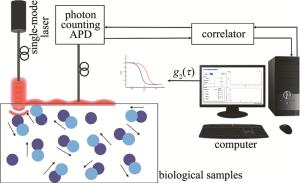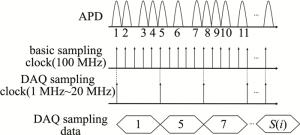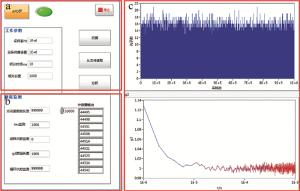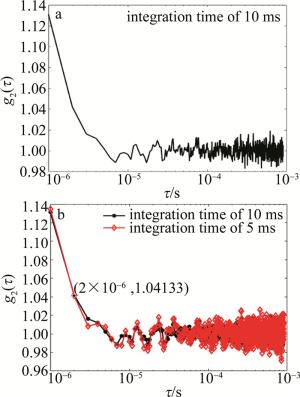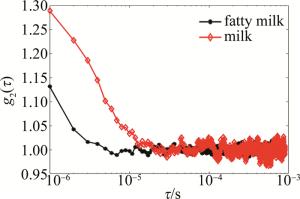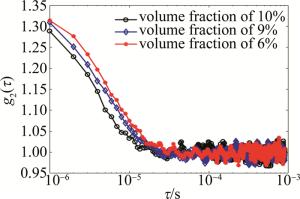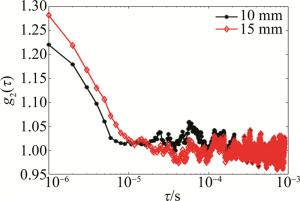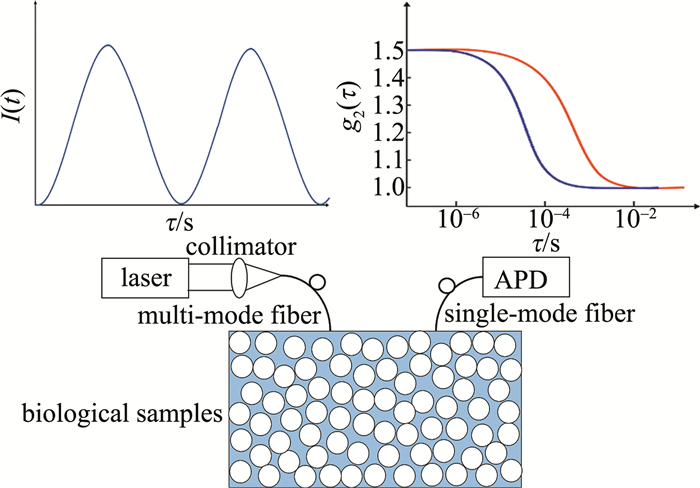-
近红外扩散相关光谱(diffusion correlation spectroscopy,DCS)是一种建立在近红外(650 nm~900 nm) 范围内无创检测组织深层血流流速变化的动态光散射技术。DCS技术通过光纤探测技术和单光子检测技术计算组织散射光斑光强时间自相关函数[1-4],从而实现组织内部深层血流流速的定量检测。相比于激光散斑技术[5-6]、激光多普勒技术[7],DCS具有更高的穿透深度,适合检测高达几厘米的深层组织。与单光子发射断层扫描、正电子发射断层扫描相比,DCS没有电离辐射,安全性更好[8],因此,DCS在癌症成像、诊断和治疗检测;中风的检测和诊断;线粒体疾病检测;癫痫症检测;脑功能活动和大脑受伤的检测;肌肉活性检测等方面得到了很好的应用。
DCS典型系统以长相干激光器作为光源,光子计数雪崩光电二极管(avalanche photo diode,APD)或光电倍增管(photomultiplier tube,PMT)作为检测器,采用光子相关器进行光强时间自相关计算。散射介质会散射进入介质的近红外光,如果散射距离大于一个平均自由程,光会因为扩散而失去了入射的方向性[9]。每个光子在组织中都经历一个“随机行走”的过程,不同传播路径的光子经过一系列散射后,在组织表面出射形成散射光斑。作为关键器件的光子相关器主要计算距离光源一定距离(通常几厘米)的光斑波动来确定单个散斑的光强时间自相关曲线[8]。传统的DCS检测系统通常采用性能良好的商用相关器实时计算光强的自相关函数[10-12],如德国兰根和新泽西州布里奇-沃特制造的相关器。但是商用相关器价格昂贵、灵活性差、计算效率低,应用受到局限。DIETSCHE等人的实验[13]实现了使用硬件相关器快速测量约40 Hz的血流量,然而该实验需要在空间中单个点对多个探测器的相关函数取平均值,更重要的是,他们将数据储存在大约只有1000个相关函数空间的硬件储存器缓冲区中,不容易用于连续的长期检测。
本文中首先详细描述了扩散相关光谱原理,然后介绍了基于软件实现的近红外扩散相关谱检测系统的硬件实现和软件实现,并利用脂肪乳和牛奶作为生物样品,验证了系统功能的可靠性,展示了利用近红外扩散相关谱测量生物样品的光学特性和动态特性。
-
近红外光在生物样品传输时会受到运动散射体的强烈散射,这种散射会引起近红外相干散射光场的相位改变,探测器可以探测这种光斑波动。相位变化受生物样品特性的影响,因此,相位的变化率可以反映生物样品内部散射颗粒的动态特性,通常用吸收系数μa和约化散射系数μs′对其进行表征[1]。
组织表面下的运动信息由位于 r处t时刻的散射光电场 E(r, t)表征,运动散射体的均方位移通常用布朗运动模型和生物组织中的随机流动模型描述[14-16]。因此,生物样品中散射光场的自相关函数可由与近红外扩散方程类似的相关谱扩散方程给出[17-18]:
$ \begin{array}{c} G_1(\boldsymbol{\rho}, \tau)= \\ \frac{3 S \mu_{\mathrm{s}}{ }^{\prime}}{4 \pi} \frac{\exp \left(-\sqrt{3 \mu_{\mathrm{a}} \mu_{\mathrm{s}}{ }^{\prime}+6 k_0{ }^2 \mu_{\mathrm{s}}{ }^{\prime} D_{\mathrm{B}} \tau} \cdot \boldsymbol{\rho}\right)}{\boldsymbol{\rho}} \end{array} $
(1) 式中:$ G_1(\boldsymbol{\rho}, \tau)=\left\langle\boldsymbol{E}^*(\boldsymbol{\rho}, t) \boldsymbol{E}(\boldsymbol{\rho}, t+\tau)\right\rangle$表示光场自相关;E(ρ, t+τ)为位于 ρ处t+τ时刻的光场强度;E*(ρ, t)为位于ρ处t时刻的光场强度复共轭;S为各向同性光源的总发射功率;DB表示散射体的有效布朗扩散系数,反映强散射介质的动态特性;τ为相关时间延迟,当时间延迟增大时,光场相关强度减小;ρ为光源与光纤探测器间的距离;k0为介质中光的波数。
通过测量样本表面的散射光强随时间的变化可以获得散射粒子的运动信息[19],光强的自相关函数为:
$ G_2(\tau)=I(t) I(t+\tau) $
(2) 式中:I(t)为t时刻的光强,表示在积分时间tint内的平均值;I(t+τ)为在t+τ时刻的光强[3]。
在实验中,光强通常比电场强度更容易获取,散射光电场归一化自相关函数g1(τ)通常由测量的光强归一化自相关函数g2(τ)给出[20],因此实际测量的是光强归一化自相关函数,即:
$ g_2(\tau)=\frac{G_2(\tau)}{I(t)^2}=\frac{I(t) I(t+\tau)}{I(t)^2} $
(3) g2(τ)能直观反映近红外光在生物组织内部的吸收和散射情况,从而反向拟合出生物组织的吸收系数μa、散射系数μs′以及散射体的运动速度等特性参数。
近红外扩散相关光谱测量过程的示意图如图 1所示。光强归一化自相关函数g2(τ)曲线的斜率表征了生物样品的动态特性[2],衰减斜率更大的曲线对应的组织中细胞运动速度更快,因此,通过计算散射光强的归一化自相关函数可以反映生物样品一定的内部特性。
-
搭建的DCS检测系统结构示意图如图 2所示。该系统由长相干激光光源、单模光纤及探头、单光子计数探测器、高速数字采集卡和计算机组成。长相干激光光源发射激光通过光纤传输至生物样品表面,携带了生物样品内部动态特性信息的散射光在样本表面被光纤探头采集,经过单光子计数探测器将采集到的光脉冲信号转成高速数字电信号,再利用采集卡采集高速数字信号,并对数字脉冲进行计数,数据通过采集卡传输至计算机进行自相关运算从而获得扩散相关光谱。利用平移台固定光源和探测器的间距,以保证不同生物样品测量数据间的联系性以及采样数据的稳定性。
选取的硬件系统各组成部分需要满足Siegert关系等条件约束。由于DCS是利用散射光斑的相干效应,为了满足相干条件,通常选用相干长度大于5 m的激光器,考虑到波长为785 nm的激光在人体组织中的吸收系数较小,因此长相干激光光源选用Laser Century公司的激光器,型号IRM785SA-070FC。DCS探测光纤用于检测散射光斑强度的变化,为避免多个散斑同时进入探头时强度会相互抵消的问题,系统采用芯径为5 μm的单模光纤。当探测光信号非常弱时,可将探测器检测到的光子视为孤立光子,单光子探测器将孤立光子转化为电脉冲信号,考虑到对单光子探测器灵敏度有较高要求,单光子探测器采用Excelitas公司的SPCM-AQRH单光子探测器,由于该单光子探测器输出100 MHz频率的晶体管-晶体管逻辑(transistor-transistor logic,TTL)电平信号,因此,采用美国NI公司最高采样时钟频率为100 MHz的PCIe-6353采集卡进行数据采集。
-
DCS检测系统数据采集与数据分析的操作系统为Windows 10(专业版64位),运行内存为16.0 GB,计算机处理器为Intel(R) Core(TM) i7-10875H CPU@2.30 GHz 2.30 GHz。
软件系统核心算法是对探测器检测到的动态激光散斑光强进行归一化自相关运算,从而获得归一化自相关函数g2(τ)。单光子探测器将探测到的光脉冲信号转换为高速TTL电脉冲信号,系统数据采样和计数原理如图 3所示。
上位机程序使用频率为fs的采样时钟去读取离散的脉冲信号,得到采样数据S(i),S(i)表示在第i·Δt时刻计数器积累的光子数,其中单位时间间隔Δt=1/fs,Nint表示积分时间tint内采样的总数,因此,Nint=tint·fs。则在第i·t的单位时间间隔内收到的光子数为s(i)=S(i+1)-S(i)。因此光强的归一化自相关函数表示为:
$ g_2\left(n=\tau f_{\mathrm{s}}\right)=\frac{\langle s(i) s(i+n)\rangle}{\langle s(i)\rangle\langle s(i+n)\rangle} $
(4) 此时,延时变量τ=n/fs,n为采样增量, 〈〉表示在(Nint-n)点范围内的平均值。光强的归一化自相关函数的公式可展开为:
$ g_2\left(\tau=n / f_{\mathrm{s}}\right)=\frac{\sum\limits_{i=1}^{N_{\text {int }}-n} s(i) s(i+n)}{\sum\limits_{i=1}^{N_{\text {int }}-n} s(i) \sum\limits_{i=n+1}^{N_{\text {int }}} s(i)}\left(N_{\text {int }}-n\right) $
(5) 采集数据时需要考虑存储空间的分配,例如设置积分时间tint=1 s,采样频率fs=1 MHz,则每次采样总数Nint为1×106个点。计数器的数据位宽是32位,4 bytes,因此,每次采样的数据至少要分配4 Mbytes的存储空间。硬件系统采集到的脉冲数值保存在采集卡内存中,上位机程序调用数据采集卡(data acquisition,DAQ)采集模块,使用低频时钟采集计数器的缓存区数据,获得采样数据S(i),DAQ采样时钟由外部信号源提供,频率fs为1 MHz~20 MHz,采样频率越高,单位时间内的采样数据量越大,但运算时间也会越长。软件的高速采样提高了采集量和测量时间分辨率,大多数DCS对样品的测量是缓慢的,高时间分辨率测量将改善对运动粒子的识别。除此之外还能够使用较少的探测器实现高空间分辨率成像,可以将成像帧率降低到秒甚至更少,从而实现动态成像。程序结构由while循环和JKI有限状态机组成[21],可以实现对动态激光散射光斑光强的长期闭环跟踪和控制,获得稳定的采样数据,解决了硬件自相关器不容易实现连续长期监测的问题,还可以利用软件自相关器实现同时监测通道的持续监测,拓展了软件自相关器在长期持续监测方面的应用。
近红外扩散相关光谱系统软件界面如图 4所示。程序模块主要包括参数设置与计数采样、相关算法和实时监测3个模块。参数设置与计数采样模块如图 4a所示,可以实现计数采集和工作参数的控制、APD开关控制、数据读取的方式选择和计数数据的分析,也可以实现软件退出及数据保存;DCS检测系统相关算法模块如图 4b所示,可以实现光子数采集,光功率显示,动态激光散斑光强的归一化自相关运算并作图显示;如图 4c所示,可以实现数据计算的实时监测。
-
使用本文中所设计的近红外扩散相关谱检测系统对标准样品脂肪乳和牛奶进行检测,将发射光纤与探测光纤的间距固定为10 mm,积分时间设置10 ms,相关长度设置为1000,后续实验均保持该工作参数不变。配制体积分数分别为10%、9%和6%的3组牛奶样品和1组体积分数为10%的脂肪乳样品,并保证样品测量空间足够大,为了降低噪声干扰,提高检测精度,每组样品测试5次取平均值。采样数据传输至计算机进行散射光斑光强归一化自相关计算,脂肪乳的光强归一化自相关函数曲线如图 5a所示。脂肪乳样品光强归一化自相关函数曲线呈单指数衰减趋势,与理论值相近,WANG等人利用近红外扩散相关谱技术对体积分数为30%的脂肪乳样品进行实验也得到了相同的结论[22],因此验证了该DCS检测系统能准确获取样品的扩散相关光谱。
改变积分时间后的g2(τ)曲线如图 5b所示。两条拟合曲线均呈现出良好的单指数衰减线型关系,且重合度较高。积分时间为5 ms时,g2(τ)的初始值略高,说明积分时间减少会导致g2(τ)初始值的增加,这反映了散射粒子的布朗运动随着相关时间的增加,光强相似度降低,因此散射光斑光强归一化自相关曲线随相关时间的改变会呈现下降的趋势。实验结果中的散射光斑光强自相关曲线随时间的变化并非是平滑的指数衰减曲线,而是包含了很多在曲线附近上下波动的点,出现这种现象的原因是因为溶液整体积分数过低,导致散射区内的粒子分布不稳定,因此产生浮动点。如果要获得更加准确的测量结果, 可适当增加脂肪乳的体积分数。值得注意的是,在使用同类仪器进行测量时,硬件相关器会抹去强度相关函数的快速波动[12]。
-
为确定该系统检测不同生物样品动态特性差异的能力,将标定后的相同体积分数牛奶样品进行检测。由图 6可见,当τ在10-6 s~10-5 s附近时,牛奶散射光斑光强归一化自相关函数曲线的衰减速率明显高于脂肪乳,该DCS系统对于不同生物样品的检测结果具有显著差异,能够区分不同的生物样品。实验结果证明,牛奶散射粒子的布朗运动比脂肪乳的散射粒子运动更快。
-
为进一步验证系统在不同体积分数的同种样品中检测功能的可行性,对标定后的3组不同体积分数牛奶样品分别进行检测和计算,结果如图 7所示。由图 7可见,不同体积分数牛奶的散射光强归一化自相关曲线之间存在一定差异,验证了该DCS系统可以用于区分不同体积分数的同种样品。图 7中曲线下降的速率是:6%牛奶>9%牛奶>10%牛奶,同种样品种散射粒子大小相同,随着牛奶体积分数的减小,散射粒子布朗运动的速率越快,光强自相关曲线下降的速率增加,即光强自相关曲线下降的速率与生物样品的体积分数成反比。
-
通过改变发射与探测光纤探头的间距,可以分析间距对DCS系统性能的影响,并确定最佳工作位置。由于光纤探头外壳的限制,两者所能达到最小间距约为10 mm,用体积分数为10%牛奶分别在间距为10 mm和15 mm处进行实验,实验结果如图 8所示。可以看出,当间距增大时,散射光强的自相关函数初始值呈减小趋势,衰减速率几乎不变。因此,改变发射光纤和探测光纤探头间距会导致散射光强自相关函数数值的改变,符合理论依据;同时也可以发现,当间距较小时,随着时间的增加,自相关曲线也更加稳定。
-
本文中开发了一种利用软件实现的近红外扩散相关谱检测系统,该系统以单纵模长相干激光器作为光源,采用单光子探测器探测散射光信号,用美国NI公司数字信号采集模块采集高速数字信号并对数字脉冲信号进行计数,基于软件完成对动态散射光斑光强归一化自相关的计算,利用该系统对脂肪乳和牛奶样品进行检测,计算得到的波动漫反射信号的时间平均强度自相关函数符合理论,验证了系统检测功能的可靠性。区别于传统的DCS系统利用硬件进行自相关计算,该系统采用软件进行自相关计算,具有体积小、成本低、灵活性好、可拓展性强的特点,为轻量化DCS检测系统的发展提供了一种新的解决方案。
近红外扩散相关光谱系统的研制
Design and experiment of a near-infrared diffusion correlation spectrum system
-
摘要: 近红外扩散相关光谱(DCS)是一种先进的无创检测组织深层血流流速变化的动态光散射技术。为了解决光子相关器价格昂贵、灵活性差、应用局限、计算效率低的问题,采用将光子相关器软件化的方法,设计了一种近红外扩散相关谱检测系统。该系统以单纵模长相干激光器作为光源,采用单光子探测器探测散射光信号,用数字信号采集模块采集高速数字信号,并对数字脉冲信号进行计数,基于软件完成了对动态散射光斑光强归一化自相关的计算。结果表明,该系统计算出生物样品波动漫反射信号的时间平均强度自相关函数符合理论,验证了系统检测功能的可靠性;在客观评价指标方面,可成功区分不同的生物样品,并且能够分别体积分数差为1%的同种生物样品。该系统可以实时监测生物样品整体的光学特性和动态特性,具有体积小、成本低、灵活性好、可拓展性强的特点,为轻量化DCS检测系统的发展提供了一种新的解决方案。Abstract: Near-infrared diffusion correlation spectroscopy (DCS) is a relatively new method widely used for blood flow detection because deep biological tissues can be penetrated by near-infrared light, which has a low absorption coefficient and strong penetrating ability. The DCS technique differed from traditional biological sample detection techniques in that it used the time-averaged intensity autocorrelation function of fluctuating diffuse reflectance signals to detect blood flow within tissues, which could achieve non-destructive and continuous quantitative detection of biological samples. In response to the problems of low computational efficiency, high system price, cumbersome operation and application limitations of the current DCS detection system by hardware technology for scattered spot attenuation calculation, a near-infrared diffusion correlation spectrum detection system based on software was proposed and designed. Considering the light source requirement for correlation, a single longitudinal mode laser was used as the light source for this system, a single photon detector was used to detect the scattered light signal, and the signal was transmitted by the digital signal acquisition module, and the calculation of normalized autocorrelation for dynamic scattered light spot intensity was performed by the software. The experimental results show that the time-averaged intensity autocorrelation function of the fluctuating diffuse reflectance signals obtained from the detection of biological samples by the system is in accordance with the theory, which verifies the reliability of the detection function of the system; in terms of objective evaluation indexes, the system successfully discriminates between different biological samples and is able to separate biological samples of the same species with a difference in volume fraction of 1%. The system can monitor the overall optical and dynamic characteristics of biological samples in real-time and is characterized by small size, low cost, good flexibility, and strong expandability, which provides a new solution for the development of a lightweight DCS detection system.
-
-
[1] BOAS D A, CAMPBELL L E, YODH A G. Scattering and imaging with diffusing temporal field correlations[J]. Physical Review Letters, 1995, 75(9): 1855-1858. doi: 10.1103/PhysRevLett.75.1855 [2] BOAS D A, MEGLINSKI I V, ZEMANY L, et al. Diffusion of temporal field correlation with selected applications[J]. Biophys, 1996, 70(2): WP306-WP306. [3] 李哲, 冯金超, 贾克斌. 扩散相关光谱组织血流检测及其临床应用[J]. 激光与光电子学进展, 2022, 59(6): 0617006. LI Z, FENG J Ch, JIA K B. Diffusion correlation spectroscopy for ti-ssue blood flow monitoring and its clinical applications[J]. Laser & Optoelectronics Progress, 2022, 59(6): 0617006 (in Chinese). [4] 梁佳明, 王晶, 梅建生, 等. 基于扩散相关光谱的血流检测方法研究[J]. 光谱学与光谱分析, 2012, 32(10): 2749-2752. LIANG J M, WANG J, MEI J Sh, et al. Study on blood flow detection method based on diffusion correlation spectroscopy[J]. Spectro-scopy and Spectral Analysis, 2012, 32(10): 2749-2752 (in Chinese). [5] 邵昆明, 吴靖, 沈英, 等. 基于空间光调制器的散斑相关成像研究[J]. 光子学报, 2021, 50(12): 1229001. SHAO K M, WU J, SHEN Y, et al. Study on scattering correlation imaging based on spatial light modulator[J]. Acta Photonica Sinaca, 2021, 50(12): 1229001 (in Chinese). [6] 王俊松, 张吴记, 潘志伟, 等. 基于激光散斑数字图像相关法的热应变测量[J]. 激光技术, 2023, 47(2): 171-177. WANG J S, ZHANG W J, PAN Zh W, et al. Thermal strain mea-surement based on laser scattering digital image correlation method[J]. Laser Technology, 2023, 47(2): 171-177 (in Chinese). [7] 叶枫, 侯昌伦. 光学多普勒无创血流测量技术的发展与现状[J]. 激光技术, 2023, 47(2): 205-213. YE F, HOU Ch L. Development and status of optical Doppler noninvasive blood flow measurement technology[J]. Laser Technology, 2023, 47(2): 205-213(in Chinese). [8] 回子帆, 谢锦斌, 何向东, 等. 一种多通道扩散相关拓扑成像系统及方法[J]. 中国激光, 2019, 46(9): 0907002. HUI Z F, XIE J B, HE X D, et al. A multi-channel diffusion correlation topography imaging system and method[J]. Chinese Journal of Lasers, 2019, 46(9): 0907002(in Chinese). [9] YODH A G. 扩散光对大脑及乳腺的功能成像和监测[J]. 光学与光电技术, 2015, 13(3): 1-4. YODH A G. Functional imaging and monitoring of brain and mammary gland by diffuse light[J]. Optics and Optoelectronics, 2015, 13(3): 1-4 (in Chinese). [10] MUNK N, SYMONS B, SHANG Y, et al. Noninvasively measuring the hemodynamic effects of massage on skeletal muscle: A novel hybrid near-infrared diffuse optical instrument[J]. Journal of Bodywork & Movement Therapies, 2011, 16(1): 22-28. [11] SHANG Y, ZHAO Y Q, CHENG R, et al. Portable optical tissue flow oximeter based on diffuse correlation spectroscopy[J]. Optics Letters, 2009, 34(22): 3556-3558. doi: 10.1364/OL.34.003556 [12] WANG D, PARTHASARATHY A B, BAKER W B, et al. Fast blood flow monitoring in deep tissues with real-time software correlators[J]. Biomedical Optics Express, 2016, 7(3): 776-797. doi: 10.1364/BOE.7.000776 [13] DIETSCHE G, NINCK M, ORTOLF C, et al. Fiber-based multispeckle detection for time-resolved diffusing-wave spectroscopy: Characterization and application to blood flow detection in deep tissue[J]. Applied Optics, 2007, 46(35): 8506-8514. doi: 10.1364/AO.46.008506 [14] BOAS D A, YODH A G. Spatially varying dynamical properties of turbid media probed with diffusing temporal light correlation[J]. Journal of the Optical Society of America, 1997, A14(1): 192-215. [15] CHEUNG C, CULVER J P, TAKAHASHI K, et al. In vivo cerebrovascular measurement combining diffuse near-infrared absorption and correlation spectroscopies[J]. Physics in Medicine and Biology, 2001, 46(8): 2053-2065. doi: 10.1088/0031-9155/46/8/302 [16] HECKMEIER M, SKIPETROV E S, MARET G, et al. Imaging of dynamic heterogeneities in multiple-scattering media[J]. Journal of the Optical Society of America, 1997, A14(1): 185-191. [17] NINNI P D, MARTELLI F, ZACCANTI G. Effect of dependent sca-ttering on the optical properties of intralipid tissue phantoms[J]. Biomedical Optics Express, 2011, 2 (8): 2265-2278. doi: 10.1364/BOE.2.002265 [18] DURDURAN T, CHOE R, BAKER W B, et al. Diffuse optics for tissue monitoring and tomography[J]. Reports on Progress in Phy-sics, 2010, 73(7): 76701-76743. doi: 10.1088/0034-4885/73/7/076701 [19] 张纾, 陈思雨, 刘玉红, 等. 基于有限元模拟的圆柱边界介质中的光传输[J]. 光子学报, 2018, 47(9): 243-252. ZHANG Sh, CHEN S Y, LIU Y H, et al. Optical transmission in cylindrical boundary media based on finite element simulation[J]. Acta Photonica Sinaca, 2018, 47(9): 243-252(in Chinese). [20] 齐甜甜, 刘伟, THOMAS J C, 等. 动态光散射颗粒测量中相关函数最优截断点的确定(英文)[J]. 光子学报, 2022, 51(3): 0329001. QI T T, LIU W, THOMAS J C, et al. Determination of optimal autocorrelation function truncation point for particle size measurement with dynamic light scattering[J]. Acta Photonica Sinica, 2022, 51(3): 0329001. [21] 张流圳, 徐磊. 基于LabVIEW的状态机设计模式应用[J]. 电子产品可靠性与环境试验, 2018, 36(S1): 110-113. ZHANG L Zh, XU L. Application of state machine design pattern based on LabVIEW[J]. Reliability and Environmental Testing of Electronic Products, 2018, 36(S1): 110-113 (in Chinese). [22] 王德田, 吕恒星, 高鹏, 等. 利用近红外扩散相关谱同时测量生物样品光学特性和动态特性[J]. 红外与毫米波学报, 2019, 38(3): 389-394. WANG D T, LYU H X, GAO P, et al. The optical properties and dynamical property of biological sample determined simultaneously by diffuse correlation spectroscopy[J]. Journal of Infrared and Millimeter Waves, 2019, 38(3): 389-394 (in Chinese). -


 网站地图
网站地图

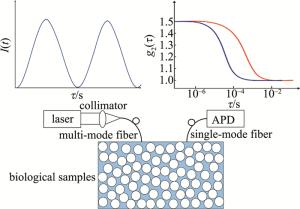
 下载:
下载:
